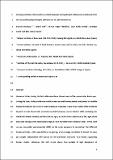Por favor, use este identificador para citar o enlazar a este item:
http://hdl.handle.net/10261/165226COMPARTIR / EXPORTAR:
 SHARE SHARE
 CORE
BASE CORE
BASE
|
|
| Visualizar otros formatos: MARC | Dublin Core | RDF | ORE | MODS | METS | DIDL | DATACITE | |

| Título: | Grazing activities in the southern central Pyrenees during the last millennium as deduced from the non-pollen palynomorphs (NPP) record of Lake Montcortès |
Autor: | Montoya, Encarnación CSIC ORCID ; Rull, Valentí CSIC ORCID ; Vegas-Vilarrúbia, Teresa; Corella, Juan Pablo CSIC ORCID; Giralt, Santiago CSIC ORCID ; Valero-Garcés, Blas L. CSIC ORCID | Palabras clave: | Fires Forest clearance Human disturbance Livestock Non-pollen palynomorphs Pyrenees |
Fecha de publicación: | jul-2018 | Editor: | Elsevier | Citación: | Review of Palaeobotany and Palynology, 254: 8-19 (2018) | Resumen: | Human activities during the last millennium have shaped most of the present-day landscapes. During this time, in the southern central Pyrenees several climate periods and phases of variable human disturbance have driven varied landscape responses. In previous studies of the sediment deposits in Lake Montcortès (southern central Pyrenees) several climatic shifts (including the Medieval Climate Anomaly and the Little Ice Age), as well as forest clearance by fire, agriculture and cattle raising as the main human impacts were recorded since Medieval times. In this work we use non-pollen palynomorphs (NPP) on the same sequence to reconstruct the different human activities, with a special focus on grazing, at an average resolution of around 30 years per sample. Independent NPP proxies for fire and forest clearance were found, supporting former studies. Moreover, the NPP record shows four periods of high abundance of coprophilous fungi: 1) 830–865 CE; 2) 1120–1290 CE; 3) 1530–1795 CE; and 4) 1865–1880 CE. These four periods correspond to phases of increased livestock farming, as reported in historical documents. Comparison of pollen, historical documents, and NPP records show that the impact on landscape dynamics during the last millennium have been mostly related to variable human population density controlled by historical, political and cultural changes in the Pyrenean mountains. Moreover, the use and comparison of several independent proxies have highlighted the strength of the indicator value obtained. © 2018 Elsevier B.V. | Versión del editor: | https://doi.org/10.1016/j.revpalbo.2018.04.005 | URI: | http://hdl.handle.net/10261/165226 | DOI: | 10.1016/j.revpalbo.2018.04.005 | ISSN: | 0034-6667 |
| Aparece en las colecciones: | (Geo3Bcn) Artículos (IQF) Artículos (IPE) Artículos (IBB) Artículos |
Ficheros en este ítem:
| Fichero | Descripción | Tamaño | Formato | |
|---|---|---|---|---|
| Montoya_Review of Palaeobotany and Palynology 254_8_postprint.pdf | 5,54 MB | Adobe PDF |  Visualizar/Abrir |
CORE Recommender
SCOPUSTM
Citations
16
checked on 20-abr-2024
WEB OF SCIENCETM
Citations
16
checked on 27-feb-2024
Page view(s)
443
checked on 12-may-2024
Download(s)
873
checked on 12-may-2024
Google ScholarTM
Check
Altmetric
Altmetric
Este item está licenciado bajo una Licencia Creative Commons

